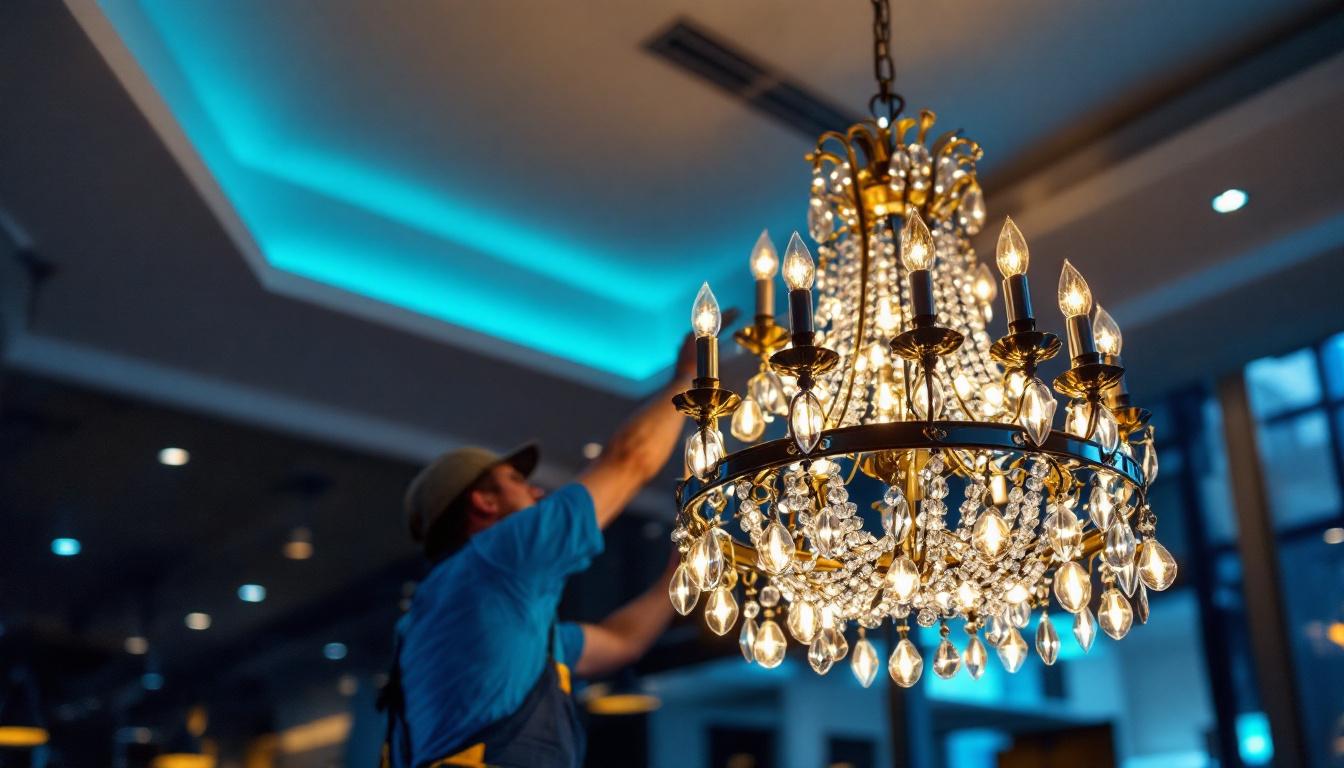
In the realm of commercial lighting, chandeliers stand out as a symbol of elegance and sophistication. They are not just functional lighting fixtures; they also serve as key design elements that can transform a space. For lighting contractors, understanding the intricacies of commercial chandeliers is essential for successful installations and client satisfaction. This guide delves into various aspects of commercial chandeliers, from design considerations to installation tips, ensuring that contractors are well-equipped to meet the diverse needs of their clients.
Commercial chandeliers are typically larger and more ornate than residential models, designed to make a statement in spaces like hotels, restaurants, and corporate offices. They come in various styles, materials, and sizes, catering to different aesthetic preferences and functional requirements. The choice of a chandelier can significantly influence the ambiance of a space, creating an inviting atmosphere that encourages guests to linger or instilling a sense of professionalism that impresses clients.
When selecting a chandelier for a commercial space, it’s crucial to consider the overall design theme of the environment. A modern office may require sleek, minimalist designs, while a luxury hotel lobby might benefit from a grand, crystal-laden chandelier. Understanding the brand identity of the business can also guide the selection process. For instance, a trendy café might opt for a quirky, artistic piece that reflects its youthful spirit, while a law firm may choose a more traditional, understated design that conveys reliability and trustworthiness.
There are several types of commercial chandeliers, each with unique characteristics and applications. The most common types include:
When evaluating chandeliers for commercial spaces, several key features should be taken into account:
In addition to these features, the maintenance requirements of the chandelier should also be considered. Commercial spaces often require fixtures that are not only visually appealing but also easy to clean and maintain. Chandeliers with intricate designs may accumulate dust and grime more quickly, necessitating regular upkeep to keep them looking their best. Furthermore, the durability of materials used in the chandelier is essential, especially in high-traffic areas where wear and tear can occur more rapidly.
Another important aspect to consider is the energy efficiency of the chandelier. With growing awareness of environmental sustainability, many businesses are opting for LED chandeliers that offer lower energy consumption and longer lifespans compared to traditional incandescent bulbs. This not only reduces electricity costs but also aligns with eco-friendly practices that many companies are striving to adopt. By making informed choices about the type of chandelier, businesses can enhance their space while also being mindful of their environmental impact.
Design plays a pivotal role in the selection and installation of commercial chandeliers. Lighting contractors must collaborate closely with clients to ensure that the chosen fixture aligns with their vision and the overall ambiance of the space.
Every business has a unique brand identity that can be reflected in its interior design choices. For lighting contractors, understanding this identity is crucial when recommending chandeliers. A high-end restaurant may require a luxurious crystal chandelier, while a tech startup might opt for a sleek, modern design.
Incorporating brand colors and themes into the chandelier design can further enhance the connection between the lighting and the business’s identity. This attention to detail can significantly impact the client’s satisfaction and the overall aesthetic appeal of the space.
Chandeliers often serve as focal points in a room, drawing the eye and setting the tone for the entire space. When designing the layout, consider how the chandelier will interact with other elements, such as furniture and architectural features.
Positioning the chandelier above key areas, such as dining tables or reception desks, can enhance its impact. Additionally, ensuring that the chandelier is visible from various angles will maximize its effectiveness as a design feature.
Chandeliers should not exist in isolation; they must work harmoniously with other lighting fixtures in the space. Task lighting, ambient lighting, and accent lighting all play a role in creating a well-lit environment.
Lighting contractors should assess the overall lighting plan to ensure that the chandelier complements other fixtures. This may involve coordinating the color temperature, brightness, and style of the chandeliers with wall sconces, recessed lighting, and floor lamps.
Installing a commercial chandelier requires careful planning and execution. Lighting contractors must adhere to safety standards and best practices to ensure a successful installation.
Safety should always be the top priority when installing chandeliers. This includes ensuring that the fixture is securely mounted and that all electrical connections are safely made. Contractors should use appropriate hardware and follow manufacturer guidelines to prevent accidents.
Additionally, using a sturdy ladder and having a second person assist during installation can help avoid injuries. It’s also advisable to turn off the power supply before beginning any electrical work to mitigate risks.
When mounting a chandelier, it is essential to select the right mounting method based on the weight and design of the fixture. For heavier chandeliers, a ceiling mount or a support brace may be necessary to ensure stability.
Contractors should also consider the type of ceiling the chandelier will be installed in. For example, a drywall ceiling may require different mounting techniques compared to a concrete or wooden ceiling. Ensuring that the chandelier is level and securely fastened will prevent future issues.
Electrical connections are a critical component of chandelier installation. Contractors must ensure that the wiring can handle the load of the chandelier and that all connections are made in compliance with local electrical codes.
Using dimmer switches can enhance the versatility of the chandelier, allowing clients to adjust the brightness according to the occasion. However, it’s important to ensure that the chandelier’s bulbs are compatible with dimming technology to avoid flickering or damage.
Once installed, chandeliers require ongoing maintenance to keep them looking their best and functioning efficiently. Educating clients on proper care can enhance the longevity of the fixture and maintain its aesthetic appeal.
Dust and grime can accumulate on chandeliers, diminishing their brilliance. Regular cleaning is essential, especially for crystal chandeliers, which require special attention to maintain their sparkle.
Contractors should recommend appropriate cleaning methods, such as using a soft cloth or a specialized chandelier cleaner. For larger fixtures, hiring professional cleaning services may be advisable to ensure thorough cleaning without risking damage.
Regular inspections can help identify any potential issues before they escalate. Contractors should advise clients to check for loose crystals, damaged wiring, or any signs of wear and tear. Addressing these issues promptly can prevent costly repairs and ensure the chandelier remains a stunning focal point.
As technology evolves, clients may wish to upgrade their chandelier lighting to more energy-efficient options. LED bulbs are a popular choice due to their longevity and lower energy consumption.
Contractors should stay informed about the latest lighting technologies and be prepared to recommend suitable upgrades. This not only enhances the functionality of the chandelier but also aligns with sustainability goals that many businesses are pursuing.
Commercial chandeliers are more than just lighting fixtures; they are integral components of a space’s design and atmosphere. For lighting contractors, understanding the nuances of these elegant fixtures is crucial for successful installations and satisfied clients. By considering design elements, installation techniques, and maintenance practices, contractors can ensure that their clients enjoy the full benefits of their chandelier investments.
As the demand for unique and impactful lighting solutions continues to grow, staying informed about the latest trends and technologies in chandelier design will empower contractors to deliver exceptional results. Ultimately, the right chandelier can elevate a commercial space, leaving a lasting impression on visitors and enhancing the overall brand experience.
Ready to bring your clients’ visions to life with stunning commercial chandeliers that blend elegance, performance, and value? At LumenWholesale, we’re committed to providing you with an exceptional selection of spec-grade lighting that meets your project’s needs and exceeds expectations. Say goodbye to inflated markups and hello to premium quality at wholesale prices, complete with the convenience of free shipping. Elevate your lighting game and make a lasting impression with every installation. Discover the perfect lighting solution for your next project at Wholesale Lighting at the Best Value.

Discover the hidden techniques lighting contractors use to master the art of LED amber lights.

Discover essential insights from lighting contractors with our quick tips on post lamps.

Discover why LED garage light bars are essential for lighting contractors—boost efficiency, save costs, and enhance workspace illumination.

Discover why the Type G Bulb E26 is a game-changer for lighting contractors.